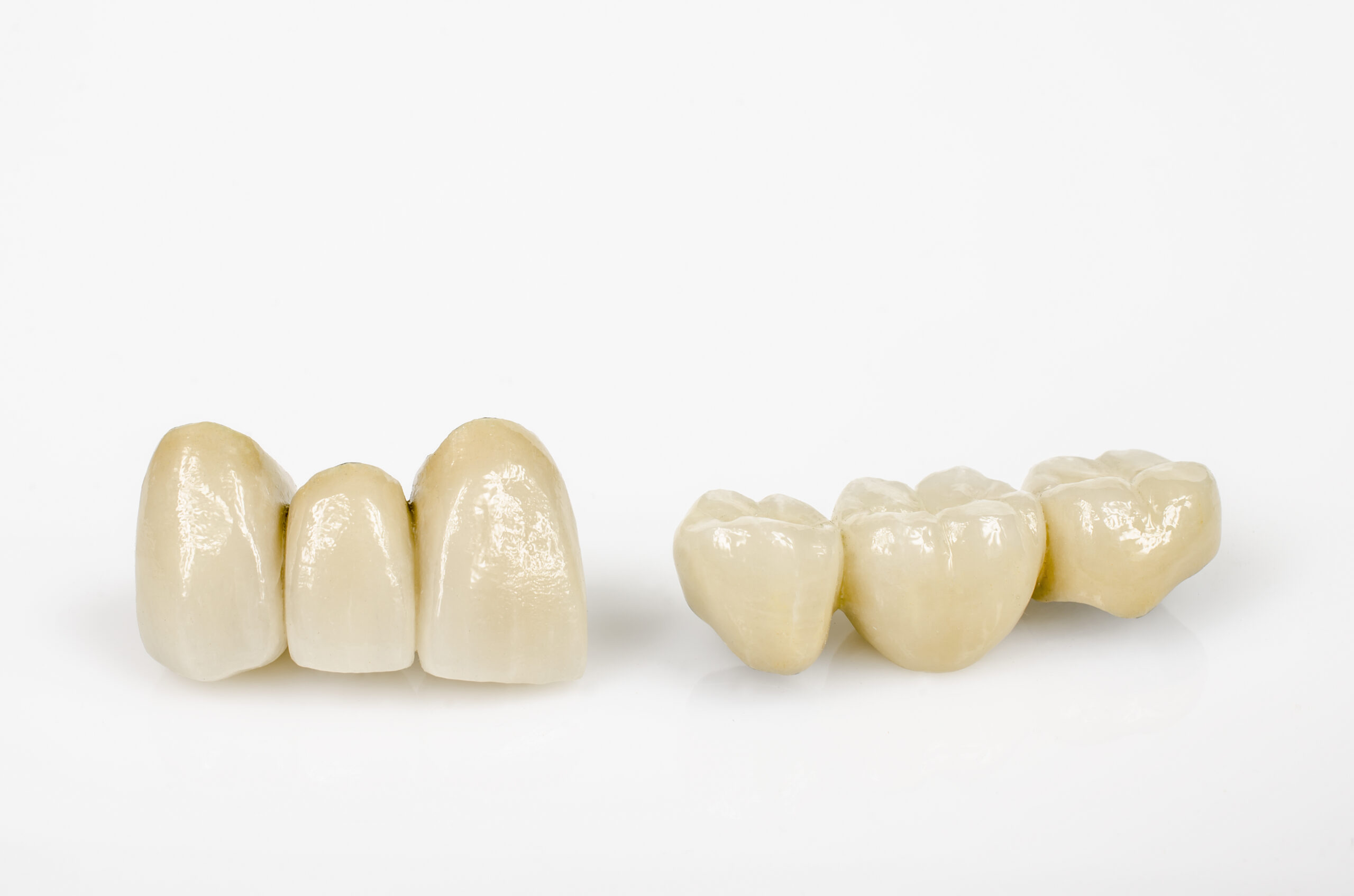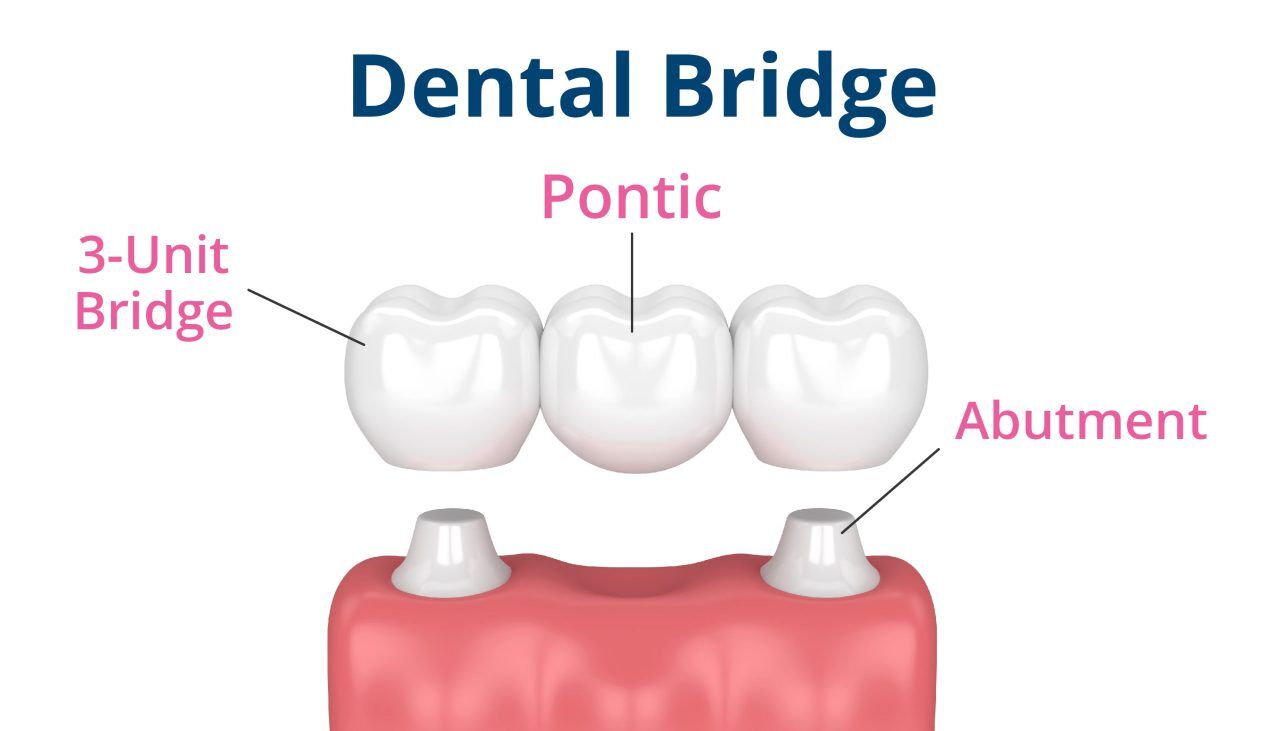Replace Missing Teeth With Dental Bridges
A dental bridge is a dental restoration that replaces one or more missing teeth by bridging the gap between two existing teeth.
The bridge comprises one or more artificial teeth (called pontics) anchored in place by dental crowns attached to the surrounding teeth.
Bridges can be made from various materials, including porcelain, ceramic, and metal alloys. The type of material used will depend on the bridge’s location, the patient’s aesthetic preferences, and other factors.
Benefits of Dental Bridges
Dental bridges can provide a long-lasting solution for replacing missing teeth and can help restore the mouth’s function and appearance.
With proper care, dental visits and at-home maintenance, a dental bridge can last 10-15 years or more and provide a durable and effective solution for restoring the smile.
Types of Dental Bridges
A traditional bridge is a dental prosthesis used to replace one or more missing teeth. It features artificial teeth (pontics) anchored by dental crowns on the natural teeth adjacent to the gap.
The process typically requires two dental appointments. First, the dentist prepares the abutment teeth by removing some tooth structure for the crowns and takes impressions to create a custom bridge. The bridge is installed at the second appointment, ensuring proper fit and comfort and is secured with a strong dental adhesive.
Advantages of traditional bridges include:
- Restoration of your smile
- Improved chewing and speaking ability
- Maintenance of facial shape
- Prevention of teeth shifting
- Even distribution of bite force, reducing strain on other teeth
- A fixed, long-lasting solution for missing teeth
However, there are drawbacks, such as removing healthy tooth structure from abutment teeth, which can affect their long-term health, and potentially higher costs compared to removable dentures. Consulting your restorative dentist can help determine if a traditional bridge is the right choice for you.
A cantilever bridge is a dental solution used to replace a missing tooth when there’s only one healthy tooth beside the gap. Instead of being supported by teeth on both sides like a traditional bridge, a cantilever bridge is secured to just one adjacent tooth.
This type of bridge is ideal in situations where there’s limited support, often used for front teeth, where biting pressure is lighter.
Cantilever bridges are not usually recommended for back teeth or molars, which handle more force from chewing.
Cantilever bridges can be a great option for restoring your smile when other types of bridges aren’t suitable. Your cosmetic dentist will assess your unique needs to determine if this approach is right for you.
A Maryland bridge, also known as a resin-bonded bridge, is a dental procedure used to replace missing teeth, especially in the front.
It consists of a prosthetic tooth (pontic) held in place by a thin metal or ceramic framework bonded to the back of adjacent teeth with a special adhesive. This method avoids drilling or altering healthy tooth structure.
Advantages of a Maryland bridge include:
- Minimal tooth reduction: No removal of healthy tooth structure is needed.
- Quick placement: It can generally be installed during a single visit.
- Cost-effective: Usually less expensive than other bridge options.
Unfortunately, Maryland bridges might not be appropriate for everyone and may not last as long as traditional bridges.
An implant-supported bridge is fixed to dental implants instead of natural teeth. Dental implants are titanium posts placed in the jawbone to act as artificial tooth roots.
The bridge connects to these implants, providing a strong and permanent solution for multiple missing teeth.
Choosing an implant-supported bridge has several benefits. Unlike traditional dental bridges, it does not rely on nearby teeth for support, so healthy teeth remain untouched. The implants also help stimulate the jawbone, preventing bone loss when teeth are missing.
This type of bridge looks and functions like natural teeth. Proper care can last many years, making it a cost-effective choice over time. It also provides better stability and comfort than dentures.
An implant-supported bridge is a great option for people missing multiple teeth who want a permanent and natural-looking solution. We offer implant-supported dental bridges at our clinics in Logan, Bray Park, and Gold Coast.
Transforming Your Smile Begins Here
Post-op photos taken directly after treatment




Improve your smile with missing tooth replacement
The process of getting a dental bridge

Dental Examination

Preparation, Impression, and Temporary Bridge

Fitting and Adjustment

Placement and Follow-Up
Amazing Smiles Restorative Dentists are committed to providing our patients with safe, effective, and long-lasting dental solutions. Our experienced dentists use the latest techniques and dental technologies to ensure you receive the best care. We are dedicated to ensuring your comfort and satisfaction throughout the dental bridge process. Trust us to restore your smile and improve oral health with a high-quality dental bridge.

Benefits of dental bridges
Dental bridges have many advantages over other options for replacing missing teeth.
First, dental bridges provide a more permanent solution than dentures. They are fixed in place, so you don’t have to take them out. This makes them feel and look more natural since they don’t shift like dentures can.
Second, dental bridges help you chew and speak better, which can improve your quality of life.
Dental bridges help keep the shape of your face, preventing a sunken mouth appearance.
Teeth bridges are a dependable option for anyone missing one or more teeth.

FAQ's for Dental Bridges
How long do dental bridges last?
The lifespan of dental bridges typically ranges from 10 to 15 years, depending on the material, location in the mouth, oral hygiene, and habits that may cause damage. To extend their life, maintain good oral hygiene by brushing and flossing regularly, and visit the dentist for check-ups and cleanings. Avoid damaging habits like chewing hard objects, using teeth as tools, or grinding teeth.
Regular dental visits are essential to monitor the bridge’s condition and catch any damage early. If a bridge becomes loose or damaged, seek dental care promptly. In some cases, a damaged bridge may need to be replaced.
How much do dental bridges cost?
The cost of a dental bridge varies based on the materials, complexity, number of teeth involved, and any additional treatments needed. It’s essential to have an initial consultation with our cosmetic dental team to get an accurate quote tailored to your situation.
Different types of dental bridges affect the cost, including:
- Traditional Bridge
- Cantilever Bridge
- Maryland Bridge
- Implant Bridge
Some dental insurance plans cover part of the expense, which helps reduce your out-of-pocket costs.
What to do if a dental bridge breaks?
If your dental bridge breaks, contact your dentist immediately. They will assess the damage and decide on the best solution, whether that’s repairing or replacing the bridge. To prevent damage, avoid biting down on hard foods or objects, and keep up with regular dental checkups to catch any issues early.
What is a pontic?
A pontic is the fake artificial tooth of a fixed dental bridge or partial denture. Pontics are either made of ceramic or porcelain with metal.
Pontics are made as a single prosthetic and look similar to a natural tooth along the gum line.

Can tooth decay still form underneath a dental bridge?
Dental decay can occur under a dental bridge if you don’t maintain proper oral hygiene, especially at the gum line where food and bacteria can accumulate.
To extend the life of your bridge, follow these practices:
- Brush twice daily
- Floss regularly
- Use antibacterial mouthwash
- Get regular dental check-ups and cleans
Avoid hard and sticky foods that can damage the bridge, and consider using a night guard if you grind or clench your teeth to prevent wear and tear.
Can I use private health to cover the cost of a dental bridge?
Patients can use private health insurance to cover dental bridge costs, but coverage varies by individual plan. Dental bridges are typically considered major procedures and may have a waiting period.
Patients should contact their insurance provider to understand the specifics of their coverage. Some plans may only cover part of the cost, leaving the patient to pay the rest. It’s also important to check for any limits on the number of bridges or annual benefits.
At Amazing Smiles, we assist patients in navigating the insurance process to maximise their coverage. We recognise that dental bridges are a significant investment and work with patients to create personalised treatment plans that fit their needs and budget.
Contact us to schedule a consultation and explore our affordable dental bridge options.
Dental Bridge Item Numbers:
Prosthodontics – Provisional Crown and Bridge
- 631 Provisional crown
- 632 Provisional bridge – per pontic
- 633 Provisional implant abutment – per abutment
- 634 Provisional implant restoration – per implant
Prosthodontics – Bridges
- 642 Bridge pontic – direct – per pontic
- 643 Bridge pontic – indirect – per pontic
- 649 Bonded retainer – indirect – per tooth
Repairs and Other Services
- 651 Recementing crown or veneer
- 652 Recementing bridge or splint – per abutment
- 655 Removal of crown
Why get a dental bridge rather than a denture?
Patients may prefer a dental bridge over a denture for several reasons:
- Permanence: A bridge is fixed in place, eliminating the need for daily removal and cleaning, which makes it more convenient.
- Stability: Unlike dentures, which can slip or shift, a bridge offers stability and improved chewing power when anchored to nearby teeth or implants.
- Aesthetic Appeal: Dental bridges are custom-made to match the shape and colour of natural teeth, often providing a more natural appearance.
Ultimately, choosing between a dental bridge and a denture depends on individual needs and preferences. Our restorative dental team can assess your situation and recommend the best treatment option.
Does diet need to change with a dental bridge?
Diet changes aren’t usually necessary with a dental bridge, but being cautious about what you eat is essential. Avoid sticky or hard foods like caramel, candy, and ice, as these can dislodge or damage the bridge. Be careful with tough meats and raw vegetables, as excessive chewing can harm the bridge and your natural teeth.
Maintain a well-balanced diet with plenty of fruits and vegetables, but consider cutting food into smaller pieces if chewing is difficult. Lastly, practice good oral hygiene by brushing and flossing regularly to prevent decay or damage to the bridge and your natural teeth.
Will a dental bridge change colour?
Over time, a dental bridge can change colour due to wear, staining from foods and drinks, or natural discolouration of nearby teeth. Regular dental cleanings and avoiding staining foods and drinks can help maintain its appearance. If necessary, the bridge may need to be replaced to restore its original colour. Dental bridges are usually made from stain-resistant materials like porcelain or zirconia, designed to match the colour of surrounding teeth.
Do you provide a warranty for dental bridges?
No, we don’t provide a warranty for dental bridges. Because every patient’s oral hygiene habits, diet, and follow-up care are different, and we can’t monitor what happens outside the clinic, our dentists can’t guarantee the longevity of a dental bridge.
Maintaining good oral hygiene, attending regular dental check-ups, and following your dentist’s care advice can help support the long-term success of your dental restoration.
We accept all major health funds

Make an Enquiry
We are proud to be preferred providers with most major health funds, allowing our patients to maximise their health cover benefits and access quality care at greater value. To make treatment more accessible, we also offer a variety of flexible payment plans, helping individuals manage the cost of their dental care in a way that best suits their financial situation.
Start your journey toward a healthier, more confident smile by booking your complimentary smile consultation with Amazing Smiles today.




